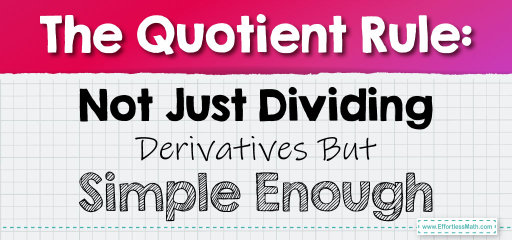The Quotient Rule: Not Just Dividing Derivatives But Simple Enough
The quotient rule for derivatives allows calculation of the derivative of a function divided by another. It is essential because the derivative of a quotient of two functions isn't simply the quotient of their derivatives, necessitating a distinct formula for accurate differentiation in various applications.

Definition:
To use quotient rule, you subtract the product of the bottom function and the derivative of the top from the product of the top and the derivative of the bottom, then divide it all by the bottom function squared. Here is the mathematical formula for the quotient rule:
\( \left(\frac{f}{g}\right)’ = \frac{f’g – fg’}{g^2} \)
Example 1:
Let’s solve an example.
\( f(x) = \sin x, \ g(x) = x^2 + 1\)
\( f'(x) = \cos x, \ g'(x) = 2x \)
\(\Rightarrow \left(\frac{\sin x}{x^2 + 1}\right)’ = \frac{\cos x \cdot (x^2 + 1) – \sin x \cdot 2x}{(x^2 + 1)^2} \)
\( = \frac{\cos x \cdot x^2 + \cos x – 2x \sin x}{(x^2 + 1)^2} \)
Example 2:
\( f(x) = x^3, \ g(x) = \cos x \)
\(f'(x) = 3x^2, \ g'(x) = -\sin x \)
\(\Rightarrow \left(\frac{x^3}{\cos x}\right)’ = \frac{3x^2 \cdot \cos x – x^3 \cdot (-\sin x)}{\cos^2 x} \)
\( = \frac{3x^2 \cos x + x^3 \sin x}{\cos^2 x} \)
Hints:
- In some complex fractions, applying logarithmic differentiation simplifies the process more than the quotient rule would.
- For \( \frac{1}{x} \) and \( \frac{1}{f(x)} \) , we use the following formulas, although \( \frac{1}{x} \) could be solved using power rule too.
\( \left(\frac{1}{x}\right)’ = -\frac{1}{x^2} \)
\( \left(\frac{1}{f(x)}\right)’ = -\frac{f'(x)}{[f(x)]^2} \)
Related to This Article
More math articles
- 8th Grade FSA Math Practice Test Questions
- How to Write a Quadratic Function from Its Vertex and Another Point
- How long is the SAT Test?
- How to Graph the Cotangent Function?
- Stem –and–Leaf Plots
- The Ultimate DAT Math Formula Cheat Sheet
- Using Number Lines to Represent Fractions
- Writing Functions
- How to Manage Your Time Effectively on the GED Math Test?
- How to Graph Absolute Value Function?


























What people say about "The Quotient Rule: Not Just Dividing Derivatives But Simple Enough - Effortless Math: We Help Students Learn to LOVE Mathematics"?
No one replied yet.